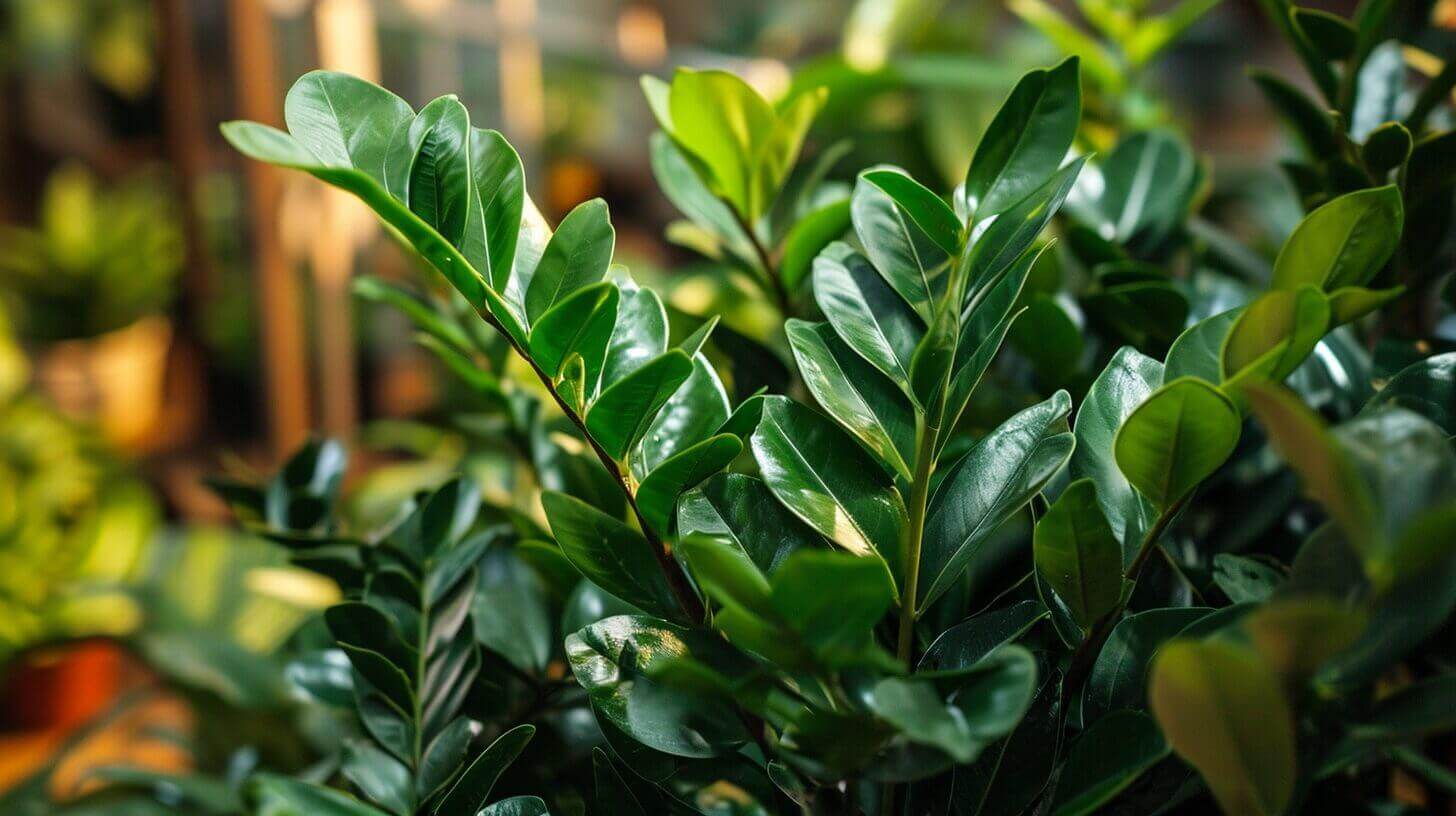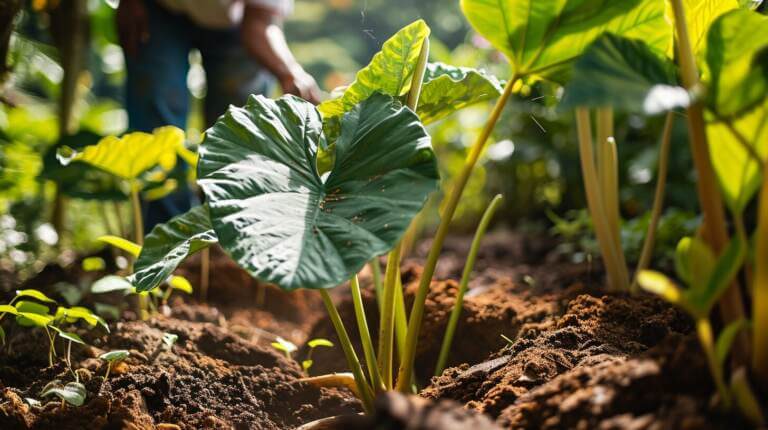How to Make Your ZZ Plant Growth: 5 Useful Tips for ZZ Plant Bushy Growth
Key Takeaways
- Select a well-draining potting mix with ingredients like perlite or vermiculite to improve drainage.
- Place your ZZ plant in a location with bright, indirect sunlight for 6-8 hours a day and rotate it regularly for even growth.
- Water the plant thoroughly but infrequently, allowing the soil to partially dry out between waterings to avoid overwatering and root rot.
- Regularly prune your ZZ plant to promote bushiness, remove dead or damaged leaves, and propagate it to encourage fuller and healthier growth.
Choose the Right Potting Mix
When selecting the appropriate potting mix, it is crucial to consider the specific needs of your ZZ plant in order to ensure optimum growth and development. Choosing the right potting mix is essential for the healthy growth of your ZZ plant. The potting mix acts as the foundation for the plant’s root system and provides essential nutrients and moisture.
A well-draining potting mix is essential for ZZ plants as they are prone to root rot if left in standing water. Look for a mix that is specifically formulated for indoor plants and contains ingredients like perlite or vermiculite to improve drainage. Additionally, a mix that retains some moisture is also important to prevent the plant from drying out completely between waterings.
It is recommended to use a mixture of peat moss, perlite, and coarse sand or orchid bark for your ZZ plant. Peat moss helps to retain moisture, while perlite and coarse sand or orchid bark ensure good drainage. This combination allows for proper air circulation and prevents waterlogging, promoting healthy root growth.
When repotting, ensure that the potting mix is fresh and sterile. Avoid using soil from your garden as it may contain pests or diseases that can harm your ZZ plant. By selecting the right potting mix, you can provide your ZZ plant with the ideal growing environment, leading to healthy and vibrant growth.
Provide Adequate Sunlight
Adequately providing sunlight is crucial for the healthy growth and development of your ZZ plant, ensuring optimum photosynthesis and promoting lush foliage. ZZ plants are native to regions with bright, indirect sunlight, so it is important to replicate these ideal lighting conditions to ensure their well-being.
Here are some tips to meet the sunlight requirements of your ZZ plant:
- Find the right spot: Place your ZZ plant in a location that receives bright, indirect sunlight for at least 6-8 hours a day. Avoid placing it in direct sunlight as it can scorch the leaves.
- Rotate regularly: ZZ plants have a tendency to grow towards the light source. To promote even growth and prevent lopsidedness, rotate the plant every few weeks to ensure all sides receive equal sunlight exposure.
- Use sheer curtains: If your ZZ plant is placed near a window with direct sunlight, you can filter the light by using sheer curtains. This will provide the plant with the necessary light intensity without damaging the leaves.
- Supplement with artificial lighting: If you don’t have access to a well-lit area, you can use artificial lighting, such as fluorescent or LED grow lights, to meet the sunlight requirements of your ZZ plant.
Water Properly and Avoid Overwatering
To maintain the health of your ZZ plant, it is important to water it properly and avoid overwatering, as this can lead to root rot and other water-related issues. ZZ plants, also known as Zamioculcas zamiifolia, are popular houseplants due to their attractive glossy leaves and ability to tolerate low light conditions. However, they are sensitive to excessive moisture in the soil, which can cause the roots to rot and eventually lead to the death of the plant.
To prevent root rot and ensure the proper growth of your ZZ plant, it is crucial to provide proper drainage. This can be achieved by using well-draining soil and a pot with drainage holes. Well-draining soil allows excess water to flow out of the pot, preventing it from pooling around the roots. Additionally, using a pot with drainage holes allows water to escape, further reducing the risk of overwatering.
When watering your ZZ plant, it is essential to water it thoroughly but infrequently. Allow the soil to dry out partially between waterings, as ZZ plants are drought-tolerant and can withstand periods of dryness. Overwatering should be avoided, as it can suffocate the roots and promote the growth of harmful fungi, leading to root rot.
Maintain Optimal Temperature and Humidity
Maintaining optimal temperature and humidity in the environment surrounding your ZZ plant is crucial for its healthy growth and development. Here are some useful tips to help you create the perfect conditions for your plant:
- Using a humidifier: ZZ plants thrive in environments with higher humidity levels. Using a humidifier can help increase the moisture in the air, creating a more favorable microclimate for your plant.
- Creating a microclimate: You can create a microclimate for your ZZ plant by grouping it with other plants or placing it on a pebble tray filled with water. This will help create a localized area with higher humidity levels, mimicking its natural habitat.
- Monitoring temperature: ZZ plants prefer temperatures between 65-75°F (18-24°C). Keep your plant away from drafts or extreme temperature fluctuations, as they can stress the plant and hinder its growth.
- Adjusting humidity levels: If you live in a dry climate, you can increase humidity levels by misting your plant regularly or placing it in a room with a humidifier. However, be cautious not to over-mist, as excessive moisture can lead to fungal issues.
Maintaining optimal temperature and humidity is just one aspect of ensuring your ZZ plant’s growth and development. In the next section, we will discuss how to prune and propagate your plant for fuller growth.
Prune and Propagate for Fuller Growth
In order to achieve fuller growth, it is essential to regularly trim and propagate your ZZ plant. Pruning and propagating are important techniques to promote bushiness and maintain the health of your plant. By removing dead or damaged leaves, you allow the plant to direct its energy towards new growth. Additionally, propagating your ZZ plant allows you to create new plants from cuttings, which can be a rewarding and cost-effective way to expand your collection.
When it comes to pruning tools, it is important to use clean and sharp instruments to prevent any damage or infection. Examples of suitable pruning tools include clean scissors or garden shears. Before pruning, it is recommended to clean the tools with a disinfectant to minimize the risk of spreading disease.
Propagation techniques involve taking stem cuttings from the mother plant and encouraging them to develop roots. This can be done by placing the cuttings in water or a well-draining propagation mix. A 2 column and 3 row table can help illustrate the steps involved in propagating a ZZ plant:
| Step | Description |
|---|---|
| Step 1 | Select a healthy stem from the mother plant. |
| Step 2 | Make a clean cut just below a node using sharp pruning tools. |
| Step 3 | Place the cutting in water or a well-draining propagation mix. |
Regular pruning and propagation will help your ZZ plant to grow fuller and healthier, creating a lush and vibrant addition to your indoor space.
Frequently Asked Questions
Can Propagating ZZ Plant Cuttings Help Make It Bushier?
Propagating ZZ plant cuttings can indeed lead to a bushier appearance. Through successful zz plant cutting propagation, new shoots will sprout from the existing stems, resulting in a fuller and more compact plant. This simple technique allows for the expansion of your ZZ plant collection while enhancing its aesthetic appeal.
Can I Use Regular Potting Soil for My ZZ Plant, or Do I Need a Specific Type of Potting Mix?
When it comes to potting soil for ZZ plants, using a specific type of potting mix is recommended rather than regular potting soil. ZZ plants thrive in well-draining soil that is slightly acidic and rich in organic matter.
A specific potting mix formulated for houseplants or tropical plants will provide the ideal conditions for the ZZ plant’s growth and development. Regular potting soil may not have the necessary characteristics, leading to suboptimal growth.
Using a specific potting mix ensures that the plant receives the proper nutrients and moisture levels it needs to flourish.
How Long Should I Leave My ZZ Plant in Direct Sunlight Each Day?
When it comes to zz plant care, one common question that arises is how long the plant should be exposed to direct sunlight. The answer to this question depends on several factors, such as the location and climate.
Generally, zz plants thrive in indirect light and can tolerate a few hours of direct sunlight each day. However, it is important to monitor the plant closely and adjust the exposure accordingly.
Following zz plant care tips will ensure that your plant receives the right amount of sunlight for healthy growth.
Is It Okay to Mist My ZZ Plant to Increase Humidity, or Should I Use a Humidifier Instead?
When it comes to increasing humidity for ZZ plants, there are two main methods to consider: misting and using a humidifier.
Misting involves spraying water onto the plant’s leaves to create a temporary increase in humidity.
On the other hand, a humidifier is a device that releases moisture into the air consistently.
Both methods have their pros and cons, and the choice ultimately depends on factors such as the plant’s specific needs, the environment it is in, and personal preference.
How can I make my ZZ plant bushy?
To encourage bushy growth, make sure your plant is getting enough light. ZZ plants tend to produce new growth when they are placed in a brighter location. However, avoid direct sunlight as it can damage the roots.
How do ZZ plants grow?
ZZ plants grow by producing new stems from the base of the plant. These stems grow upwards and develop leaves, contributing to the overall bushy appearance of the plant.
What should I do to make a ZZ plant grow?
To make a ZZ plant grow, provide plenty of light, but not direct sunlight. Also, watering your plant appropriately and fertilizing your ZZ plant during the growing season can help.
What is new growth in ZZ plants?
New growth in ZZ plants refers to the development of new stems and leaves. This usually happens during the growing season and is a sign of a healthy plant.
Is a ZZ plant a good houseplant?
Yes, a ZZ plant is an excellent houseplant. It’s easy to care for and can tolerate a range of growing conditions.
Why is my ZZ plant leggy?
A ZZ plant may become leggy if it’s not getting enough light. Moving your plant to a brighter location can help address this issue.
When is the growing season for ZZ plants?
The growing season for ZZ plants is typically the warmer months during the year. This is when you’ll see the most new growth.
How often should I fertilize my ZZ plant?
You should fertilize your ZZ plant once every month during the growing season. Make sure to use a fertilizer designed to provide nutrients that support plant growth.
How should I water my ZZ plant?
Water your ZZ plant when the top inch of soil feels dry. Overwatering can damage the roots and hinder plant growth.
How does a ZZ plant stay healthy?
A ZZ plant stays healthy with enough light exposure, regular watering but not overwatering, and periodic fertilization. Also, make sure your plant is in an environment with suitable growing conditions.
What are some helpful tips for caring for my ZZ plant?
Some helpful tips include providing enough but not direct light, watering appropriately, fertilizing during the growing season, and ensuring your plant is in a suitable environmentThis simple technique allows for the expansion of your-bushy-5-useful-tips-for-fuller-growth”>How to Make Your ZZ Plant Growth: 5 Useful Tips for ZZ Plant Bushy Growth
Key Takeaways
- Select a well-draining potting mix with ingredients like perlite or vermiculite to improve drainage.
- Place your ZZ plant in a location with bright, indirect sunlight for 6-8 hours a day and rotate it regularly for even growth.
- Water the plant thoroughly but infrequently, allowing the soil to partially dry out between waterings to avoid overwatering and root rot.
- Regularly prune your ZZ plant to promote bushiness, remove dead or damaged leaves, and propagate it to encourage fuller and healthier growth.
Choose the Right Potting Mix
When selecting the appropriate potting mix, it is crucial to consider the specific needs of your ZZ plant in order to ensure optimum growth and development. Choosing the right potting mix is essential for the healthy growth of your ZZ plant. The potting mix acts as the foundation for the plant’s root system and provides essential nutrients and moisture.
A well-draining potting mix is essential for ZZ plants as they are prone to root rot if left in standing water. Look for a mix that is specifically formulated for indoor plants and contains ingredients like perlite or vermiculite to improve drainage. Additionally, a mix that retains some moisture is also important to prevent the plant from drying out completely between waterings.
It is recommended to use a mixture of peat moss, perlite, and coarse sand or orchid bark for your ZZ plant. Peat moss helps to retain moisture, while perlite and coarse sand or orchid bark ensure good drainage. This combination allows for proper air circulation and prevents waterlogging, promoting healthy root growth.
When repotting, ensure that the potting mix is fresh and sterile. Avoid using soil from your garden as it may contain pests or diseases that can harm your ZZ plant. By selecting the right potting mix, you can provide your ZZ plant with the ideal growing environment, leading to healthy and vibrant growth.
Provide Adequate Sunlight
Adequately providing sunlight is crucial for the healthy growth and development of your ZZ plant, ensuring optimum photosynthesis and promoting lush foliage. ZZ plants are native to regions with bright, indirect sunlight, so it is important to replicate these ideal lighting conditions to ensure their well-being.
Here are some tips to meet the sunlight requirements of your ZZ plant:
- Find the right spot: Place your ZZ plant in a location that receives bright, indirect sunlight for at least 6-8 hours a day. Avoid placing it in direct sunlight as it can scorch the leaves.
- Rotate regularly: ZZ plants have a tendency to grow towards the light source. To promote even growth and prevent lopsidedness, rotate the plant every few weeks to ensure all sides receive equal sunlight exposure.
- Use sheer curtains: If your ZZ plant is placed near a window with direct sunlight, you can filter the light by using sheer curtains. This will provide the plant with the necessary light intensity without damaging the leaves.
- Supplement with artificial lighting: If you don’t have access to a well-lit area, you can use artificial lighting, such as fluorescent or LED grow lights, to meet the sunlight requirements of your ZZ plant.
Water Properly and Avoid Overwatering
To maintain the health of your ZZ plant, it is important to water it properly and avoid overwatering, as this can lead to root rot and other water-related issues. ZZ plants, also known as Zamioculcas zamiifolia, are popular houseplants due to their attractive glossy leaves and ability to tolerate low light conditions. However, they are sensitive to excessive moisture in the soil, which can cause the roots to rot and eventually lead to the death of the plant.
To prevent root rot and ensure the proper growth of your ZZ plant, it is crucial to provide proper drainage. This can be achieved by using well-draining soil and a pot with drainage holes. Well-draining soil allows excess water to flow out of the pot, preventing it from pooling around the roots. Additionally, using a pot with drainage holes allows water to escape, further reducing the risk of overwatering.
When watering your ZZ plant, it is essential to water it thoroughly but infrequently. Allow the soil to dry out partially between waterings, as ZZ plants are drought-tolerant and can withstand periods of dryness. Overwatering should be avoided, as it can suffocate the roots and promote the growth of harmful fungi, leading to root rot.
Maintain Optimal Temperature and Humidity
Maintaining optimal temperature and humidity in the environment surrounding your ZZ plant is crucial for its healthy growth and development. Here are some useful tips to help you create the perfect conditions for your plant:
- Using a humidifier: ZZ plants thrive in environments with higher humidity levels. Using a humidifier can help increase the moisture in the air, creating a more favorable microclimate for your plant.
- Creating a microclimate: You can create a microclimate for your ZZ plant by grouping it with other plants or placing it on a pebble tray filled with water. This will help create a localized area with higher humidity levels, mimicking its natural habitat.
- Monitoring temperature: ZZ plants prefer temperatures between 65-75°F (18-24°C). Keep your plant away from drafts or extreme temperature fluctuations, as they can stress the plant and hinder its growth.
- Adjusting humidity levels: If you live in a dry climate, you can increase humidity levels by misting your plant regularly or placing it in a room with a humidifier. However, be cautious not to over-mist, as excessive moisture can lead to fungal issues.
Maintaining optimal temperature and humidity is just one aspect of ensuring your ZZ plant’s growth and development. In the next section, we will discuss how to prune and propagate your plant for fuller growth.
Prune and Propagate for Fuller Growth
In order to achieve fuller growth, it is essential to regularly trim and propagate your ZZ plant. Pruning and propagating are important techniques to promote bushiness and maintain the health of your plant. By removing dead or damaged leaves, you allow the plant to direct its energy towards new growth. Additionally, propagating your ZZ plant allows you to create new plants from cuttings, which can be a rewarding and cost-effective way to expand your collection.
When it comes to pruning tools, it is important to use clean and sharp instruments to prevent any damage or infection. Examples of suitable pruning tools include clean scissors or garden shears. Before pruning, it is recommended to clean the tools with a disinfectant to minimize the risk of spreading disease.
Propagation techniques involve taking stem cuttings from the mother plant and encouraging them to develop roots. This can be done by placing the cuttings in water or a well-draining propagation mix. A 2 column and 3 row table can help illustrate the steps involved in propagating a ZZ plant:
| Step | Description |
|---|---|
| Step 1 | Select a healthy stem from the mother plant. |
| Step 2 | Make a clean cut just below a node using sharp pruning tools. |
| Step 3 | Place the cutting in water or a well-draining propagation mix. |
Regular pruning and propagation will help your ZZ plant to grow fuller and healthier, creating a lush and vibrant addition to your indoor space.
Frequently Asked Questions
Can Propagating ZZ Plant Cuttings Help Make It Bushier?
Propagating ZZ plant cuttings can indeed lead to a bushier appearance. Through successful zz plant cutting propagation, new shoots will sprout from the existing stems, resulting in a fuller and more compact plant. This simple technique allows for the expansion of your ZZ plant collection while enhancing its aesthetic appeal.
Can I Use Regular Potting Soil for My ZZ Plant, or Do I Need a Specific Type of Potting Mix?
When it comes to potting soil for ZZ plants, using a specific type of potting mix is recommended rather than regular potting soil. ZZ plants thrive in well-draining soil that is slightly acidic and rich in organic matter.
A specific potting mix formulated for houseplants or tropical plants will provide the ideal conditions for the ZZ plant’s growth and development. Regular potting soil may not have the necessary characteristics, leading to suboptimal growth.
Using a specific potting mix ensures that the plant receives the proper nutrients and moisture levels it needs to flourish.
How Long Should I Leave My ZZ Plant in Direct Sunlight Each Day?
When it comes to zz plant care, one common question that arises is how long the plant should be exposed to direct sunlight. The answer to this question depends on several factors, such as the location and climate.
Generally, zz plants thrive in indirect light and can tolerate a few hours of direct sunlight each day. However, it is important to monitor the plant closely and adjust the exposure accordingly.
Following zz plant care tips will ensure that your plant receives the right amount of sunlight for healthy growth.
Is It Okay to Mist My ZZ Plant to Increase Humidity, or Should I Use a Humidifier Instead?
When it comes to increasing humidity for ZZ plants, there are two main methods to consider: misting and using a humidifier.
Misting involves spraying water onto the plant’s leaves to create a temporary increase in humidity.
On the other hand, a humidifier is a device that releases moisture into the air consistently.
Both methods have their pros and cons, and the choice ultimately depends on factors such as the plant’s specific needs, the environment it is in, and personal preference.
How can I make my ZZ plant bushy?
To encourage bushy growth, make sure your plant is getting enough light. ZZ plants tend to produce new growth when they are placed in a brighter location. However, avoid direct sunlight as it can damage the roots.
How do ZZ plants grow?
ZZ plants grow by producing new stems from the base of the plant. These stems grow upwards and develop leaves, contributing to the overall bushy appearance of the plant.
What should I do to make a ZZ plant grow?
To make a ZZ plant grow, provide plenty of light, but not direct sunlight. Also, watering your plant appropriately and fertilizing your ZZ plant during the growing season can help.
What is new growth in ZZ plants?
New growth in ZZ plants refers to the development of new stems and leaves. This usually happens during the growing season and is a sign of a healthy plant.
Is a ZZ plant a good houseplant?
Yes, a ZZ plant is an excellent houseplant. It’s easy to care for and can tolerate a range of growing conditions.
Why is my ZZ plant leggy?
A ZZ plant may become leggy if it’s not getting enough light. Moving your plant to a brighter location can help address this issue.
When is the growing season for ZZ plants?
The growing season for ZZ plants is typically the warmer months during the year. This is when you’ll see the most new growth.
How often should I fertilize my ZZ plant?
You should fertilize your ZZ plant once every month during the growing season. Make sure to use a fertilizer designed to provide nutrients that support plant growth.
How should I water my ZZ plant?
Water your ZZ plant when the top inch of soil feels dry. Overwatering can damage the roots and hinder plant growth.
How does a ZZ plant stay healthy?
A ZZ plant stays healthy with enough light exposure, regular watering but not overwatering, and periodic fertilization. Also, make sure your plant is in an environment with suitable growing conditions.
What are some helpful tips for caring for my ZZ plant?
Some helpful tips include providing enough but not direct light, watering appropriately, fertilizing during the growing season, and ensuring your plant is in a suitable environment.







